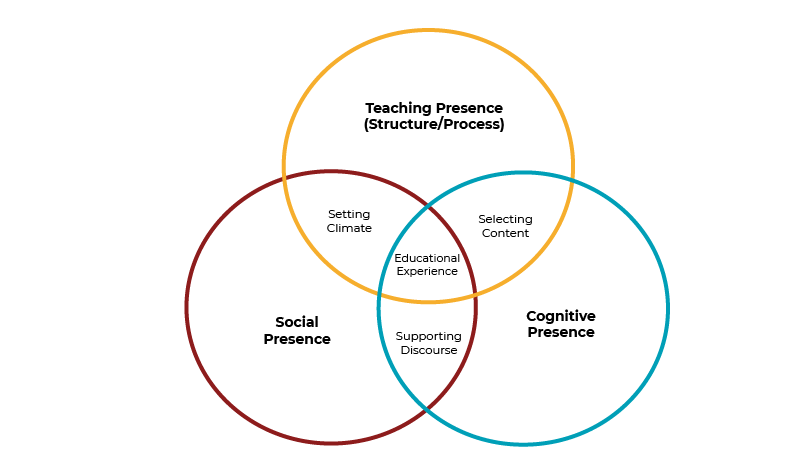Module 4: Quality facilitation and improvement
4.3 Introduction to the Community of Inquiry framework
What is the Community of Inquiry framework?
In 2000, when online higher education was in its infancy, Garrison, Anderson, and Archer published a seminal paper introducing a theoretical model for approaching online courses and discussions called Community of Inquiry. Since then, the model has been widely adopted by educators and researchers across the world of online education (Garrison, 2017). The model details three essential types of presence that form the building blocks of a course community— a community of inquiry.
The three presences are
- teaching presence,
- social presence, and
- cognitive presence.
D. Randy Garrison is professor emeritus at the University of Calgary. For four decades, Garrison has been one of Canada’s leading researchers in the field of distance and online education, with his best known work centring on validating and improving the Community of Inquiry framework, which he helped to develop.

(pfrench, n.d.)
Traditional education models have implicitly centred on educational communities from the very start. Every classroom is a small community of people brought together to explore a subject (cognitive presence), learn from an expert (teaching presence), and support one another through it all (social presence). As the above diagram shows, these three key types of presence overlap one another during the processes whereby course communities select content, support discourse, and set a climate for learning. Moreover, these types of presence are just as important when teaching online as they are in a classroom.
Humans learn best when they learn in a community featuring social, cognitive, and teaching presence.
When facilitating an online course, however, building a sense of community may not come naturally, especially when you are first getting started. It is often important to be intentional and plan how you will build and contribute to the learning community in the course you are teaching. For this reason, it is helpful to break down the concept of community into the three presences above (teaching, social, and cognitive presence) in order to make sure all three types of presence are available in a given course. Let’s review each in more detail below.
Teaching presence
Ensuring that learners experience your teaching presence is perhaps the most essential goal to keep in mind when teaching your online course. While we often think of “presence” as implying physical proximity to other people, teaching presence is something that can be created in spite of any distance, and which conversely may not arise automatically even in an in-class course. Rather than a direct effect of physical distance, presence is something experienced (or not) by your learners wherever they are.
When learners are aware that you are invested in your course and in their learning, that they can turn to you for help with their learning, and that they can rely on your support, they experience your teaching presence. Learners who experience the presence of their instructor online are much more likely to complete the course and succeed in their learning goals. We will talk about some strategies for creating teaching presence online and provide some real-world examples.
Cognitive presence
Cognitive presence encompasses the many forms of mental transformation that learners (and instructors!) undergo as a result of engaging in a learning experience. Expansion of knowledge and skill, shaping of critical perspectives, and construction of meaning and understanding are all types of cognitive presence. Much of what goes into helping learners experience cognitive presence in your course happens during the design phase (discussed in the previous three modules). For these reasons, we will talk a little less about cognitive presence in this module as compared to teaching and social presence.
The three forms of presence identified in the Community of Inquiry framework overlap to create an overall educational experience for your learners. While much of the work of fostering these types of presence is done when designing your course, keep all three of them in mind as you begin teaching during term and ask yourself the following key question:
How can I actively support each form of presence from the Community of Inquiry framework as my course goes along?

